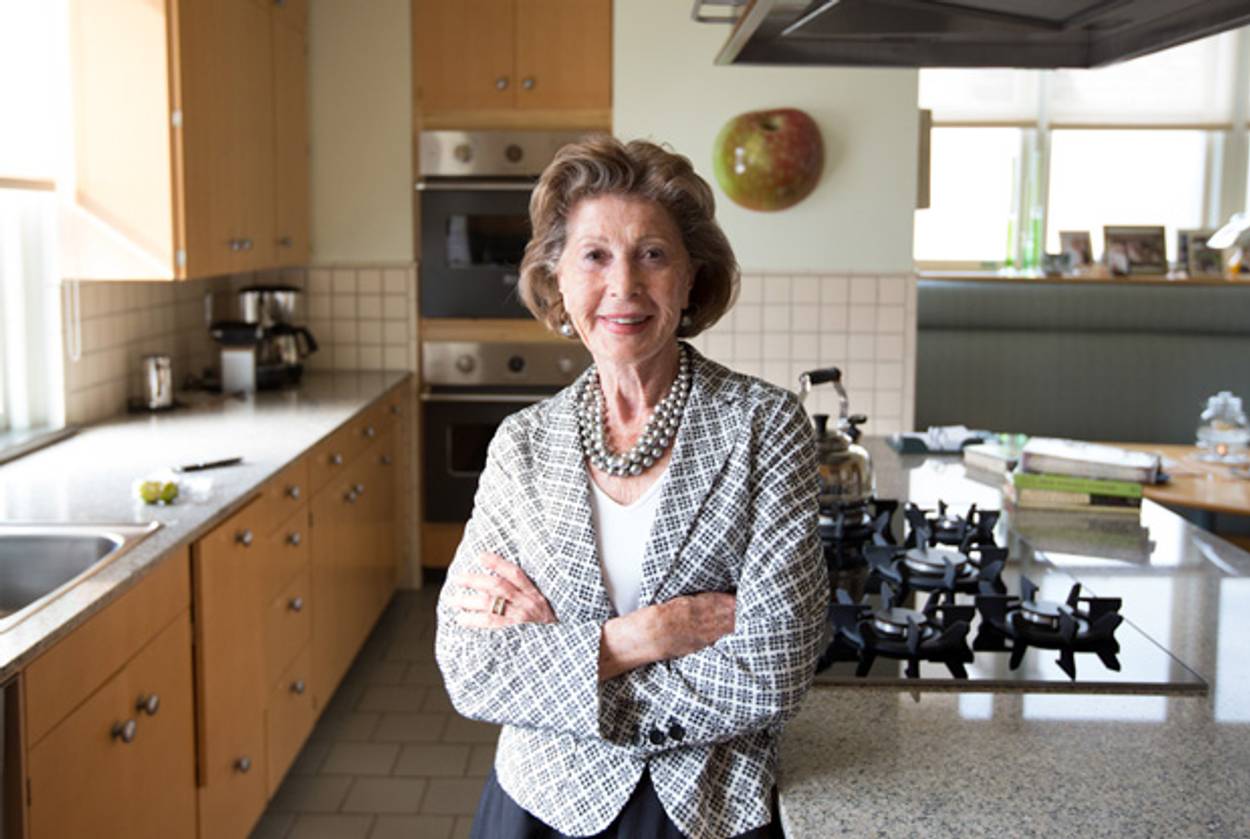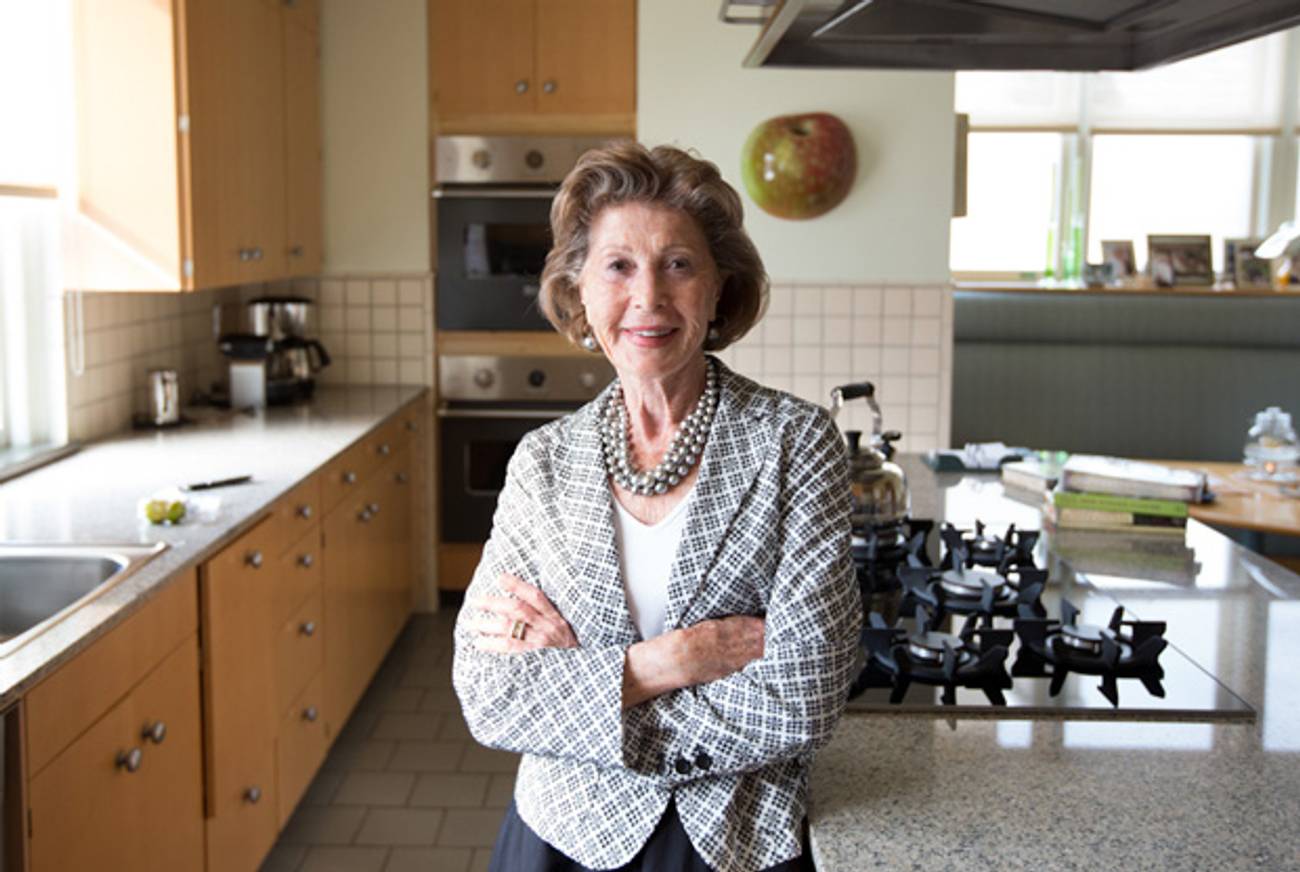At Home With Helen Nash
In New Kosher Cuisine, one of the doyennes of kosher home cooking takes her fare in a simpler direction




For Helen Nash, one of the doyennes of kosher home cooking, writing cookbooks is a way to share meals with other people when her own table feels empty. She began working on her first book, the 1984 classic Kosher Cuisine, when her two children left for college and followed it four years later with Helen Nash’s Kosher Kitchen, written while her husband, financier Jack Nash, was busy building his pioneering Odyssey Partners hedge fund.
This week, she has a third volume coming out, Helen Nash’s New Kosher Cuisine, which she wrote in the wake of her husband’s death in 2008, five years after he was left incapacitated by a stroke. “I was sinking into an abyss, and I realized I had to do something,” Nash told me, in her matter-of-fact way, when I visited her Park Avenue apartment recently. “This anchored me.” In her sunny kitchen, she served a summery ginger tea (fresh ginger, honey, and lime) with an assortment of pastries: a flourless torte (chocolate, nuts, and prunes bound with egg white), delicate crescent-shaped shortbread cookies, and chocolate almond truffles. “Those who cook,” she said, offering a plate of raspberries and donut peaches, “it’s because someone is there to appreciate it.”
In addition to simplified, retooled versions of traditional Jewish favorites like chopped liver and gravlax, the new book includes low-fat recipes Nash developed while caring for her husband—spinach pie, roasted cauliflower, tuna pasta—that serve as weekday staples. Where her earlier books included dinner-party showstoppers like quenelles, her focus now reflects both the changes in her life and in popular cooking habits since the days when “kosher” automatically meant “heavy.” “I always told Jack I married him for better or worse but not for lunch,” Nash told me. “I didn’t have a repertoire of lunch.” But having him home during the day for the first time in their half-century of marriage prompted her to perfect dishes like stuffed portobello mushrooms, vegetable frittatas, and, at the fancier end, a sole and parmesan soufflé that can, Nash promises, be prepared in advance.
Nash’s first book, which was published by Random House, represented something new in kosher cookbooks: a guide to preparing modern, elegant meals that divorced the rules of kashrut from ethnic Jewish, and mainly Ashkenazic, mainstays. “One can easily understand how guests at Mrs. Nash’s table seldom realize that they are eating kosher meals,” wrote Craig Claiborne, the New York Times’ legendary food critic, when Kosher Cuisine came out. The book went on to shape a generation of young cooks, just as Orthodox Jews were looking to expand their culinary horizons and as less-observant Jews were getting more interested in keeping kosher.
“I got it at my bridal shower,” said Susie Fishbein, author of the best-selling Kosher by Design series. Kosher Cuisine was, she said, one of the only kosher bibles of the time that didn’t focus on heavy holiday meals and traditional foods. “Every bride on Long Island got The Melting Pot, the community cookbook, and there was Spice and Spirit, the Lubavitch cookbook, which was not fancy but you’d go to when you made your first Rosh Hashanah,” Fishbein continued. “But people were traveling, and it’s exciting to cook from other cultures—and Helen saw that and brought it into people’s homes.”
It’s a long way from where Nash started as a newlywed in 1957, when, as she is fond of saying, she didn’t even know how to make corn on the cob. “I knew nothing, literally nothing,” she told me. She was born Helen Englander in Krakow in 1935 into a home attended by servants; her mother, she said, was one of the first career women in Poland, working in her family’s textile business. “My mother apparently never cooked before the war,” Nash told me. “And then it was the war, and even after the war, there was no food.”
With her parents and sister, Nash was deported to Siberia in 1939 and returned west via Tashkent. They obtained visas to the United States after the war from a sympathetic consul in Prague after Nash’s father, who had been in the spirits business before the war, took a friend’s advice to grow a beard and say he was a rabbi. They reunited with her maternal grandparents in Brooklyn’s Williamsburg neighborhood—they had been sponsored by cousins in Hoboken, N.J.—and eventually settled in Crown Heights. (A younger brother, Israel Englander, was born after the family’s arrival in the United States; he now runs the Millennium Management hedge fund.)
Through it all, Nash said, they kept kosher, a task made easier by meat shortages during and after the war. While they had been completely modern in their Orthodoxy in Krakow, Nash’s mother was descended from the Babad rabbinic dynasty, and the family was not open to compromise—not even when Helen Englander met Jack Nash at a friend’s wedding reception in New York. The son of a well-to-do Berlin family, Jack Nash arrived in New York in 1941 and managed to gain entry to Stuyvesant High School despite speaking very little English; he went on to City College and then to work as a trainee at the investment house Oppenheimer & Company, where he eventually became chairman. “He was Jewish, but he had not been brought up in an Orthodox way,” Nash told me. “It was quite traumatic for my family to accept him, but he was a very persuasive man.”
Her one stipulation was that their kitchen had to be kosher, which meant she had to learn not just to cook, but to cook well, in order to cater dinner parties for her husband’s business associates. Like a kosher Julia Child, Nash signed up for cooking classes with an array of luminaries: Michael Field, Lydie Marshall, Marcella Hazan. After an attempt at suburban living in White Plains, the Nashes settled on Manhattan’s Upper East Side with their children Pamela and Joshua, who became their mother’s first taste-testers. (Pamela is now married to the investor George Rohr, the son of philanthropist Sami Rohr; Joshua runs Ulysses Management, a successor fund to Odyssey, and is a trustee of the Jewish Museum.) “The children would sit at the table and do their homework,” Nash told me. “Michael Field taught me a lemon tart, which Jack liked very much, but I wanted to achieve the custard filling without baking it,” she said. “It went on and on, and the kids finally said they never wanted to see another lemon tart again.”
But Nash encouraged her teachers to rethink their own approaches, too. Field, she said, would improvise on her behalf, telling her to substitute smoked salmon for ham in quiche Lorraine, and Millie Chan, the legendary Chinese cooking teacher, credited Nash with helping inspire her landmark 1990 cookbook Kosher Chinese. “Millie knew nothing about kosher, but she said, ‘Helen, if you’re prepared to buy a wok, and you bring the ingredients, you bring the meat, then you can learn,’ ” Nash told me.
Today, the kosher landscape is radically different, changed not just by people’s tastes but by the vast expansion of kosher certification for specialty products. “Wasabi! Who ever heard of wasabi with a hekhsher?” Nash asked me, shaking her head in wonder. The widespread availability of such products allowed her to include a far greater range of dishes in New Kosher Cuisine than in her earlier books, like curried beef wontons and black cod with miso. But, Nash said, the expansion of kosher prepared foods and restaurants also gave her something to rally against. “Back then it was a crusade, you know, asking why castigate kosher, because the Italian food at the time was also too oily and too overcooked and too gray,” Nash told me. “Now I’m interested in women who work, who have careers, but who still want to plan a menu and entertain and not be frantic because someone’s coming for dinner, and at the same time eat healthfully and eat well.”
***
Like this article? Sign up for our Daily Digest to get Tablet Magazine’s new content in your inbox each morning.
Allison Hoffman is a senior editor at Tablet Magazine. Her Twitter feed is @allisont_dc.
Apricot Soufflé, from Helen Nash’s New Kosher Cuisine
Soufflés have a reputation for being difficult to make at the last minute. I think this recipe represents something of a breakthrough. You can prepare part of the dessert well in advance, and another part half an hour before baking. And it’s well worth the effort, as this is a heavenly dish—light, not too sweet, and very special.
¼ pound (113g) dried California apricots (see note)
1 ¼ cups (300ml) cold water
7 (98 g) tablespoons sugar
1 ½ tablespoons freshly squeezed lemon juice
2 tablespoons (30g) unsalted margarine, for greasing the ramekins
3 large egg whites (see note)
Boiling water, as needed
Place the apricots and water in a medium enamel saucepan. Bring to a boil, lower the heat, and cook, covered, for 15 minutes or until the apricots are soft. Cool for a bit.
Purée the mixture in a blender until very smooth. Add 4 tablespoons of the sugar and 1 tablespoon of the lemon juice and blend. Pour the mixture into a container and refrigerate for at least 1 hour. (You can also do this the day before you will be baking the soufflés.)
Grease eight ½-cup (125 ml) ramekins with the margarine and sprinkle them with 2 tablespoons of the sugar (see note). Invert the ramekins and tap to remove the excess sugar. Place them in a 9-by-13-by-2-inch (23-by-33-by-5-cm) baking pan and refrigerate for at least 30 minutes.
Meanwhile, preheat the oven to 375°F (190°C).
Place the egg whites in the bowl of an electric strand mixer. Using the balloon whisk attachment, beat at high speed until foamy. Gradually add the remaining tablespoon of sugar and the remaining ½ tablespoon of lemon juice. Continue beating until the egg whites form stiff, shiny peaks.
With a rubber spatula, fold half of the whites into the apricot purée. Reverse the process, pouring the apricot purée into the bowl with the egg whites. Gently fold the two mixtures together, making a motion like a figure 8 with the spatula, until most of the whites have disappeared. Take care not to over-blend.
Spoon the batter into the prepared ramekins. If you are not baking the soufflés immediately, they will keep for half an hour in the refrigerator.
When ready to bake, pour enough boiling water into the baking pan to reach one-third of the way up the sides of the ramekins. Bake the soufflés on the middle shelf of the oven for 15 minutes.
If you are not serving them right away, you can leave them in the turned-off oven for about 10 minutes.
***
Notes:
I always use California apricots when I make this dish because they are less sweet than other varieties.
It is easier to separate the eggs straight from the refrigerator, when they are cold. Make sure the whites have come to room temperature before beating.
You can also bake the soufflé in a 1-quart (1 liter) soufflé dish. Grease the dish, sprinkle it with sugar, and place in a baking pan. After filling it with the batter and pouring the boiling water as described above, bake for 22 minutes.
Allison Hoffman is a senior editor at Tablet Magazine. Her Twitter feed is @allisont_dc.